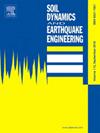Seismic isolation effect and parametric analysis of simply supported beam bridges with multi-level sliding friction adaptive isolation bearing
IF 4.2
2区 工程技术
Q1 ENGINEERING, GEOLOGICAL
引用次数: 0
Abstract
In response to the shortcomings of isolation bridge limit devices and friction dampers, a sliding friction bearing exhibiting multi-level working behavior (MSFB) is proposed. Its structure and mechanism are introduced, and a multi-condition quasi-static test is conducted using ABAQUS software. Through comparative analysis of theory and experiment, the theoretical model's accuracy and multi-level sliding friction mechanism of MSFB are verified. The mechanical parameters of MSFB are analyzed, clarifying the influence of various main mechanical parameters on the mechanical performance. The performance parameters of the MSFB are optimized based on a two-degree-of-freedom analysis model for a high-speed railway single-pier bridge equipped with MSFBs. The findings indicate that the seismic responses of MSFB is comprehensively affected by all the parameters, and the variation pattern is complex. By optimizing these performance parameters, MSFB can satisfy the multi-level performance demands of bridges subjected to varying earthquake intensities, and achieve the optimal control effect. The MSFB offers superior isolation efficiency during minor and moderate earthquakes and can substantially decrease the internal forces within the bridge substructure when utilized as a bridge isolation and limit device. During intense and infrequent earthquakes, the MSFB demonstrates remarkable displacement-limiting capacity and good self-centering and energy dissipation abilities.
采用多级滑动摩擦自适应隔震支座的简支梁桥的隔震效果和参数分析
针对隔离桥限位装置和摩擦阻尼器的缺点,提出了一种具有多级工作行为的滑动摩擦支座(MSFB)。介绍了其结构和机理,并使用 ABAQUS 软件进行了多工况准静力试验。通过理论与实验的对比分析,验证了 MSFB 理论模型的准确性和多级滑动摩擦机理。分析了 MSFB 的力学参数,明确了各种主要力学参数对力学性能的影响。基于二自由度分析模型,对装有 MSFB 的高速铁路单孔桥的 MSFB 性能参数进行了优化。研究结果表明,MSFB 的地震响应受所有参数的综合影响,且变化规律复杂。通过优化这些性能参数,MSFB 可以满足不同地震烈度下桥梁的多层次性能需求,达到最佳控制效果。MSFB 在小震和中震时具有优异的隔震效率,作为桥梁隔震和限位装置使用时可大幅降低桥梁下部结构的内力。在强烈和不频繁的地震中,MSFB 具有显著的位移限制能力,以及良好的自定心和消能能力。
本文章由计算机程序翻译,如有差异,请以英文原文为准。
求助全文
约1分钟内获得全文
求助全文
来源期刊

Soil Dynamics and Earthquake Engineering
工程技术-地球科学综合
CiteScore
7.50
自引率
15.00%
发文量
446
审稿时长
8 months
期刊介绍:
The journal aims to encourage and enhance the role of mechanics and other disciplines as they relate to earthquake engineering by providing opportunities for the publication of the work of applied mathematicians, engineers and other applied scientists involved in solving problems closely related to the field of earthquake engineering and geotechnical earthquake engineering.
Emphasis is placed on new concepts and techniques, but case histories will also be published if they enhance the presentation and understanding of new technical concepts.
 求助内容:
求助内容: 应助结果提醒方式:
应助结果提醒方式:


